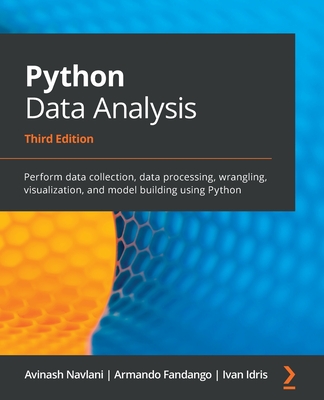Learning scikit-learn: Machine Learning in Python (Paperback)
暫譯: 學習 scikit-learn:Python 中的機器學習 (平裝本)
Raúl Garreta, Guillermo Moncecchi
- 出版商: Packt Publishing
- 出版日期: 2013-11-25
- 售價: $1,270
- 貴賓價: 9.5 折 $1,207
- 語言: 英文
- 頁數: 118
- 裝訂: Paperback
- ISBN: 1783281936
- ISBN-13: 9781783281930
-
相關分類:
Python、程式語言、Machine Learning
海外代購書籍(需單獨結帳)
買這商品的人也買了...
-
 基礎資料結構 ─ 使用 C++ (Fundamentals of Data Structures in C++, 2/e)
基礎資料結構 ─ 使用 C++ (Fundamentals of Data Structures in C++, 2/e)$790$774 -
 Hijack Development Pack
Hijack Development Pack$2,850$2,793 -
 Java 程式設計藝術, 9/e (國際版) (Java How to Program, 9/e)
Java 程式設計藝術, 9/e (國際版) (Java How to Program, 9/e)$880$792 -
 Hadoop 技術手冊, 3/e (Hadoop: The Definitive Guide, 3/e)
Hadoop 技術手冊, 3/e (Hadoop: The Definitive Guide, 3/e)$880$695 -
 無瑕的程式碼-敏捷軟體開發技巧守則 (Clean Code: A Handbook of Agile Software Craftsmanship)
無瑕的程式碼-敏捷軟體開發技巧守則 (Clean Code: A Handbook of Agile Software Craftsmanship)$580$452 -
 解構 ZBrush-專家技巧徹底解析
解構 ZBrush-專家技巧徹底解析$580$452 -
 王者歸來-PHP 完全開發範例集, 2/e
王者歸來-PHP 完全開發範例集, 2/e$860$731 -
 超圖解 Arduino 互動設計入門, 2/e
超圖解 Arduino 互動設計入門, 2/e$680$578 -
 深入淺出 Node.js
深入淺出 Node.js$560$437 -
 ASP.NET MVC 5 網站開發美學
ASP.NET MVC 5 網站開發美學$780$616 -
 菲絲恩教你學會 Python
菲絲恩教你學會 Python$300$234 -
 3ds Max/VRay 居家設計透視圖表現技法, 4/e
3ds Max/VRay 居家設計透視圖表現技法, 4/e$680$578 -
 Raspberry Pi 2B 機殼開關電源儲存HDMI套件包
Raspberry Pi 2B 機殼開關電源儲存HDMI套件包$2,250$2,205 -
 Android App 程式設計教本之無痛起步 -- 使用 Android Studio 開發環境
Android App 程式設計教本之無痛起步 -- 使用 Android Studio 開發環境$550$468 -
 R 軟體資料分析基礎與應用 (R for Everyone: Advanced Analytics and Graphics)
R 軟體資料分析基礎與應用 (R for Everyone: Advanced Analytics and Graphics)$650$553 -
 人工智慧的未來:揭露人類思維的奧祕 (How to Create a Mind: The Secret of Human Thought Revealed)
人工智慧的未來:揭露人類思維的奧祕 (How to Create a Mind: The Secret of Human Thought Revealed)$500$395 -
 大話重構
大話重構$390$332 -
 Make 國際中文版 vol.19 (Make: Volume 43 英文版)
Make 國際中文版 vol.19 (Make: Volume 43 英文版)$260$234 -
 Effective Python 中文版 | 寫出良好 Python 程式的 59 個具體做法 (Effective Python: 59 Specific Ways to Write Better Python)
Effective Python 中文版 | 寫出良好 Python 程式的 59 個具體做法 (Effective Python: 59 Specific Ways to Write Better Python)$450$356 -
 Windows 軟體安全實務 -- 緩衝區溢位攻擊
Windows 軟體安全實務 -- 緩衝區溢位攻擊$480$379 -
 精通 Python|運用簡單的套件進行現代運算 (Introducing Python: Modern Computing in Simple Packages)
精通 Python|運用簡單的套件進行現代運算 (Introducing Python: Modern Computing in Simple Packages)$780$616 -
 完整學會 Git, GitHub, Git Server 的24堂課
完整學會 Git, GitHub, Git Server 的24堂課$360$284 -
 演算法的樂趣|23個程式設計必學主題與應用實例
演算法的樂趣|23個程式設計必學主題與應用實例$480$379 -
 物聯網如何改變世界(The Internet of Things: How Smart TVs, Smart Cars, Smart Homes, and Smart Cities Are Changing the World)
物聯網如何改變世界(The Internet of Things: How Smart TVs, Smart Cars, Smart Homes, and Smart Cities Are Changing the World)$380$323 -
 Java 網站安全防護實務手冊|軟體開發安全技術的九大黃金準則
Java 網站安全防護實務手冊|軟體開發安全技術的九大黃金準則$360$284
商品描述
Incorporating machine learning in your applications is becoming essential. As a programmer this book is the ideal introduction to scikit-learn for your Python environment, taking your skills to a whole new level.
Overview
- Use Python and scikit-learn to create intelligent applications
- Apply regression techniques to predict future behaviour and learn to cluster items in groups by their similarities
- Make use of classification techniques to perform image recognition and document classification
In Detail
Machine learning, the art of creating applications that learn from experience and data, has been around for many years. However, in the era of “big data”, huge amounts of information is being generated. This makes machine learning an unavoidable source of new data-based approximations for problem solving.
With Learning scikit-learn: Machine Learning in Python, you will learn to incorporate machine learning in your applications. The book combines an introduction to some of the main concepts and methods in machine learning with practical, hands-on examples of real-world problems. Ranging from handwritten digit recognition to document classification, examples are solved step by step using Scikit-learn and Python.
The book starts with a brief introduction to the core concepts of machine learning with a simple example. Then, using real-world applications and advanced features, it takes a deep dive into the various machine learning techniques.
You will learn to evaluate your results and apply advanced techniques for preprocessing data. You will also be able to select the best set of features and the best methods for each problem.
With Learning scikit-learn: Machine Learning in Python you will learn how to use the Python programming language and the scikit-learn library to build applications that learn from experience, applying the main concepts and techniques of machine learning.
What you will learn from this book
- Set up scikit-learn inside your Python environment
- Classify objects (from documents to human faces and flower species) based on some of their features, using a variety of methods from Support Vector Machines to Naïve Bayes
- Use Decision Trees to explain the main causes of certain phenomenon such as the Titanic passengers’ survival
- Predict house prices using regression techniques
- Display and analyse groups in your data using dimensionality reduction
- Make use of different tools to preprocess, extract, and select the learning features
- Select the best parameters for your models using model selection
- Improve the way you build your models using parallelization techniques
Approach
The book adopts a tutorial-based approach to introduce the user to Scikit-learn.
Who this book is written for
If you are a programmer who wants to explore machine learning and data-based methods to build intelligent applications and enhance your programming skills, this the book for you. No previous experience with machine-learning algorithms is required.
商品描述(中文翻譯)
將機器學習整合到您的應用程式中變得越來越重要。作為一名程式設計師,本書是您在 Python 環境中學習 scikit-learn 的理想入門書籍,將您的技能提升到全新的水平。
**概述**
- 使用 Python 和 scikit-learn 創建智能應用程式
- 應用回歸技術來預測未來行為,並學習根據相似性將項目分組
- 利用分類技術進行圖像識別和文件分類
**詳細內容**
機器學習,即創建能夠從經驗和數據中學習的應用程式的藝術,已經存在多年。然而,在「大數據」時代,產生了大量的信息。這使得機器學習成為解決問題的新數據驅動近似方法的不可避免來源。
透過《Learning scikit-learn: Machine Learning in Python》,您將學會如何在應用程式中整合機器學習。本書結合了機器學習的一些主要概念和方法的介紹,以及針對現實世界問題的實用實例。從手寫數字識別到文件分類,示例將使用 Scikit-learn 和 Python 逐步解決。
本書首先簡要介紹機器學習的核心概念,並提供一個簡單的示例。然後,通過實際應用和進階功能,深入探討各種機器學習技術。
您將學會評估結果並應用數據預處理的進階技術。您還將能夠為每個問題選擇最佳的特徵集和最佳的方法。
透過《Learning scikit-learn: Machine Learning in Python》,您將學會如何使用 Python 程式語言和 scikit-learn 函式庫來構建能夠從經驗中學習的應用程式,應用機器學習的主要概念和技術。
**您將從本書中學到什麼**
- 在您的 Python 環境中設置 scikit-learn
- 根據某些特徵對物件(從文件到人臉和花卉物種)進行分類,使用從支持向量機到朴素貝葉斯的各種方法
- 使用決策樹解釋某些現象的主要原因,例如泰坦尼克號乘客的生存
- 使用回歸技術預測房價
- 使用降維技術顯示和分析數據中的群組
- 利用不同工具進行預處理、提取和選擇學習特徵
- 使用模型選擇為您的模型選擇最佳參數
- 使用並行化技術改善模型構建的方式
**方法**
本書採用基於教程的方法來介紹使用 Scikit-learn。
**本書的讀者對象**
如果您是一名希望探索機器學習和基於數據的方法來構建智能應用程式並提升程式設計技能的程式設計師,那麼這本書就是為您而寫的。不需要具備機器學習算法的先前經驗。










